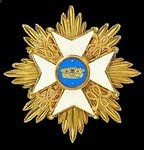First raised in 1674, Cossé Brissac Infanterie had 2 battalions and in 1757 was part of Soubise's Army of Saxony. The regiment was at Rossbach, brigaded with the St Chamond regiment. Cossé Brissac was in the left hand column of the three infantry columns just behind St Chamond; it was also badly mauled and its colonel was wounded and taken prisoner. The depleted regiment was sent back to France to reform and from 1758-61 was on the coast of Brittany. From 1761-2 it was in Germany. From 1762 it was renamed after the province of Vivarais.
The flags of this regiment are very confusing - not to mention somewhat hallucinogenic in appearance! Although the four colours in each quarter are recorded in e.g. the État Général of 1753, their actual placement is not clear. Every modern version I have seen differs, so I have decided to use the contemporary depiction on the 1757 manuscript, as shown below. Contemporary does not always mean correct, of course, but in this case I prefer this version - it also seems more convincing to me.
And this plate shows the uniform and flags as depicted in 1757:





















